Certified Professional in Healthcare Quality Examination Questions and Answers
An organization is shifting paradigms from top-down leadership to participatory management. The process of moving forward includes the four identified phases below:
gathering baseline data
evaluating effectiveness and improvement
making the commitment
implementing the program
Which of the following is the most logical sequence for these phases?
A patient safety officer is developing a patient safety program. The following information has been reviewed:
Incident report data
Performance indicators
Customer complaintsWhich of the following additional information is needed prior to writing the patient safety plan?
What is the first step in turning an organization’s long-term goals into an operational plan for improvement?
The facility's compliance rate on pain assessment is shown below:
Compliance Rate on Pain Assessment
January
February
March
Physicians
40%
50%
20%
Nurses
80%
75%
83%
Physical Therapists
60%
55%
50%
To improve performance, what should be done next?
A criterion is considered valid if it
A team has completed several tests of change and has arrived at a recommendation. In order to facilitate change, which of the following should occur first?
An organization has Implemented a quality improvement project. The goal is a mean compliance rate of 90%. The results of observations are found in the table below:

Which focus area presents the greatest opportunity for the organization?
When prioritizing quality improvement initiatives, which of the following should take the highest priority?
Before patient outcome data can be used for benchmarking, the data should be
The healthcare quality professional has been asked to participate in the organizations population health program related to cost and utilization.
Based on this Information, what Is the next action the quality professional should take?
A goal of measurement is to collect valid and reliable data that reflects
Which of the following is the primary benefit of the initial phase brainstorming?
An organization has compiled the scatter plots below:
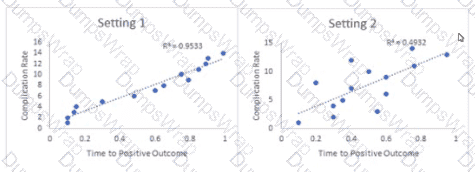
Based on these plots, which of the following conclusions can be made by the quality professional?
Integration of a quality culture within an organization Is best demonstrated by
An organization IsImplementing a new electronic medical record and has employed a project manager. At the first meeting, the project manager observes the following:
• The team estimates It Is one-fourth finished with Identifying benchmark organizations.
• Team members have not yet begun to identify the current state.
- They are halfway through collecting public data, which puts them slightly behind schedule for that task.
Which of the following tools should the quality Improvement project manager recommend?
An outpatient medical clinic wants to test whether a relationship exists between two factors: lack of available transportation and the number of times patients do not keep appointments. Which of the following tools should be used?
A nursing director for a unit in a cancer hospital Is reviewing and assessing outcomes data in the followingscatter diagram:
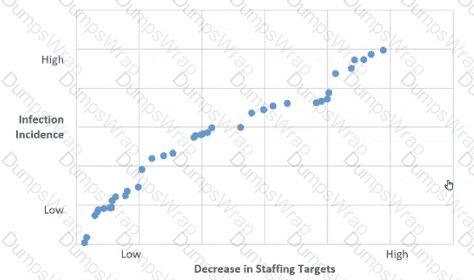
The relationship between the incidence of infection and the decrease in staffing targets is
An organization has a goal to increase profitability of services covered under bundled payments. Which of the following aspects of quality should a healthcare quality professional recommend as a starting point for an analysis?
Which of the following population health strategies is most likely to improve rural patient access to mental healthcare services?
A provider requests to see the peer review file on another provider in their department. What is the healthcare quality professional’s most appropriate response?
A facility plans to provide a new specialty. Which of the following will best provide information on the effectiveness of the specialty?
Which of the following is the best approach tomotivate stakeholders across the care continuum to take action?
Cold-spotting involves identifying populations that
Which of the following is the most effective method to identify adverse events that cause harm to patients?
Data for an organization's annual Influenza vaccine administration yields the following results:
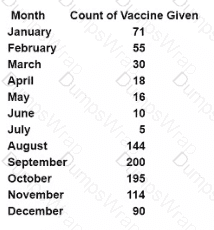
What is the median for the organization's annual vaccine count?
Reviewing organizational priorities, addressing regulatory requirements, and identifying goals for the next year are important components in the development of which of the following?
A focused professional practice evaluation (FPPE) Is Initiated
While the use of technology may result in fewer medical errors. In order for this strategy to be most effective. It should be supported by
A performance improvement team is looking at data from similar medical centers to improve patterns of care. This method of assessment is known as:
Which of the following best describes the goal of the Healthy People Initiative?
Which of the following best represents an "unsafe condition"?
Senior leaders of a managed care organization have consulted a healthcare quality professional on the purchase of a clinical data management software system to support performance improvement. Which of the following should be considered first?
The most important component of a successful performance improvement program is:
Which of the following is the most effective data display tool to demonstrate changes in monthly patient fall rates for the past fiscal year?
Where could a quality professional find data on causes ofinfant mortality?
Quality measures must be relevant, scientifically sound, and
A hospital installed a new patient safety event reportingsystem. During the failure modes and effects analysis (FMEA), decreased use of the system and complexity of reporting were identified as potential failures. What should the team use to determine which failure mode to address first?
Which of the following is true of a clinical pathway?
Which initiative should a quality professional promote in an organization seeking to optimize value-based reimbursement?
A healthcare quality professional wants to find out whether the community served Is satisfied with the care provided. The organization serves patients who live within a 10-mile radius. The healthcare quality professional mails a survey to households within 3 miles of the organization. What type of bias has been Introduced?
Data from an Incident reporting system compares Incident rates for one facility to similar facilities:
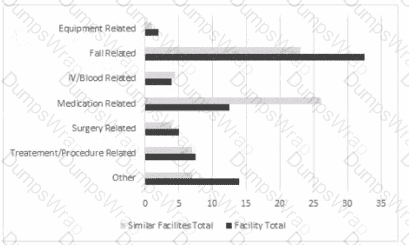
After reviewing the graph, which of the following should be done first?
The preferred culture in promoting patient safety
The quality manager needs to identify a set of process measures to improve wound care outcomes. The first step should be to
Following evaluation of the compounding process used by a pharmacy, the batch compounding consistently yields 12% more drug than Is needed. The excess Is stored until used or expired. Which of the following types of waste should be recorded when reporting this finding?
Which of the following Is an algorithm that Is designed to classify patients according to their acuity?
Hospitals must be in compliance with the Centers for Medicare and Medicaid Services (CMS) Conditions of Participation in order to
The following hospital Medicare readmission findings are available:
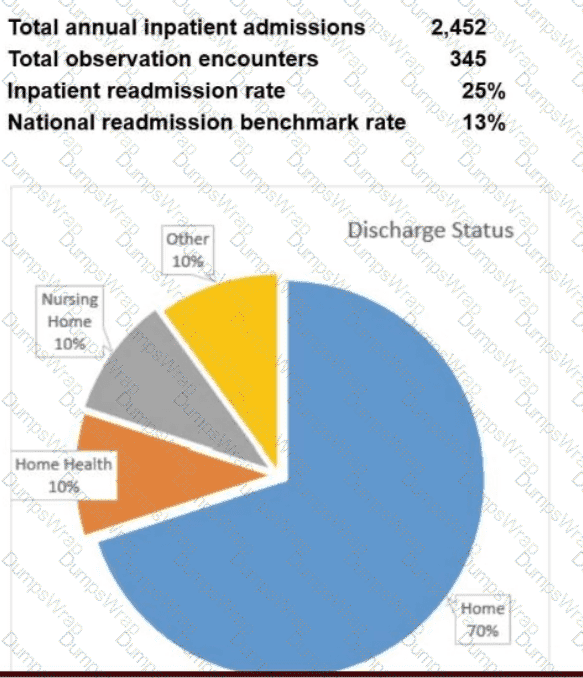
Based on the provided information and an understanding of factors that drive readmissions, the hospital should first
A team has identified that labeled cutting boards are needed in a kitchen to decrease cross-contamination. After a new process has been implemented, it is discovered that the labeled cutting boards are not being used. Which of the following is the next action the team should take?
A provider’s Ongoing Professional Practice Evaluation (OPPE) profile is shown below. In this organization, if a provider partially meets or does not meet performance expectations, they are referred to peer review for a Focused Professional Practice Evaluation (FPPE).
Fully Meets: >80% of measures at threshold
Meets: 65% to 80% of measures at threshold
Partially Meets: 40% to 64% of measures threshold
Does Not Meet: <40% of measures at thresholdAfter reviewing this provider’s overall profile, what should the healthcare quality professional suggest?
Measure
Performance
Threshold
Direction
Timely Medical Record Documentation
95%
90%
Higher
Readmission Rate
13%
10%
Lower
Surgical Site Infection Rate
9%
5%
Lower
Use of Pre-procedure timeouts
100%
100%
Higher
Patient Experience Score (Top Box)
94%
80%
Higher
Clinical Pathway Adherence
81%
70%
Higher
When implementing a new process or procedure, which of the following tools should be used to anticipate and prevent potential problems?
A performance improvement team has been examining delays in getting admissions from the emergency department (ED) to the coronary care unit. The team has collected data and determined that a significant number of delays are occurring because cardiologists are not consulting on their patients in the ED in a timely manner. The best way to communicate this information to the cardiologists is to:
To maintain continuity, let’s assume a question aligned with CPHQ domains, such as:
What is a key step in sustaining a performance improvement initiative?
Which of the following stages may cause continuous quality improvement teams to dissolve prematurely?
An organization that demonstrates a culture of safety
A patient safety program can best be enhanced by which of the following technologies?
A healthcare organization has been providing cardiac care to patients. Leaders areinterested in seeing how their outcomes compare with other organizations that are providing similar care. Which of the following types of programs should this organization consider participating in?
What is the initial step an organization should take when the strategic goal of improving patient satisfaction has not been met?
A healthcare organization has recently launched a diabetes center of excellence to address the needs of its patients with advanced diabetes. The implementation of this program would fall into which of the following types of prevention?
Which of the following is the best example of a patient-centered approach in healthcare?
How can a quality professional best engage stakeholders in the organization's quality efforts?
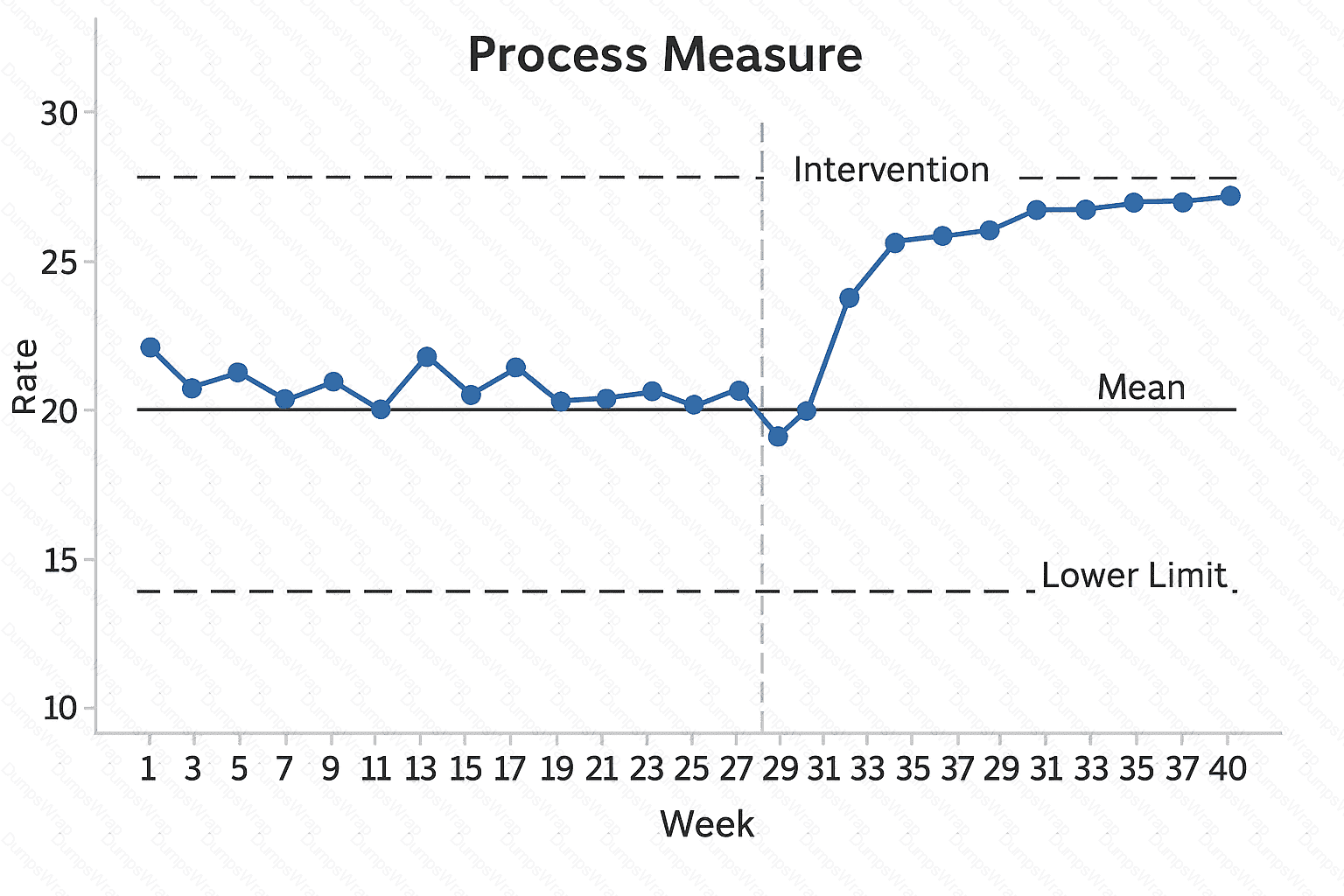
The chart above is used by a team to document process improvement results following an intervention that was implemented during the 20th week. Based on this chart, the team can conclude:
A quality professional is creating a training session for clinical leaders about quality improvement. Which of the following should be incorporated into the training?
Which of the following is an example of improving primary prevention strategies?
An interdisciplinary team met to review readmission rates at a health system. Issues were identified withcommunication across care providers. The team is interested in improving the coordination of care process and is now reviewing four candidates to serve in the role of process champion:
Of the four candidates, which represents the most effective choice to serve as a process champion?
Which of the following is the most effective method for communicating an organization’s quality improvement efforts?
A healthcare quality professional is looking at a control chart and notices that last November the number of admissions for flu symptoms exceeded the upper control limit. This most likely represents:
A healthcare organization has Introduced an Initiative to Increase lung cancer screenings for Itspatient population with a history of smoking. This screening would fall into which of the following types of prevention?
A team has identified five opportunities for improvement related to patient wait times. Which of the following is the best tool for selecting the opportunity with the highest impact?
Which of the following would be the best methodology to reduce referral wait time?
A surgeon left a sponge in one patient, resulting in a multi-million dollar lawsuit. The organization immediately changed the operating room procedure so that after every surgery, patients receive an x-ray before leaving the operating room. Which of the following should the organization have done prior to changing the procedure?
A nursing home has established a quality indicator to accomplish a 5% reduction in falls. A guideline has been developed and implemented. After six months, the goal has not been reached. The next action steps should include
When allocating limited resources to meet strategic objectives, management decisions should be driven by
A managed care peer review committee should obtain which of the following first?
A stated purpose of the National Committee for Quality Assurance (NCQA) Healthcare Effectiveness Data and Information Set (HEDIS) public reporting is that accountable health care should:
In aligning an organization's performance Improvement plan with strategic goals, a healthcare quality professional should consider
A hospital wants to place increased emphasis on risk adjustment and cost as part of its innovation strategy. The quality leadership team recognizes that in order to appropriately identify severity of illness, they will need to work with providers and the
An improvement project was implemented to expand utilization of primary care services in a rural area where only 5% of residents sought primary care. The team established a goal of 20% of residents using primary care. The table below shows the results for the four months following implementation of the improvement:
% Residents Using Primary Care
Time | %
Baseline | 5%
Month 1 | 15%
Month 2 | 20%
Month 3 | 21%
Month 4 | 22%
Which of the following should the quality professional recommend to the organization?
Which of the following tools is most appropriate to analyze a medication administration process?
Technology design that prevents a certain action, or requires that another action happen first, is said to have
Recognition of the formal and informal structure of an organization is necessary when implementing a quality improvement program because
Which of the following is the best way to evaluate the success of a performance improvement team?
A new pediatric psychiatric unit will open in one year. The utilization coordinator is responsible for developing the utilization management program. The program's success will depend on which of the following factors?
Which of the following is the key responsibility of a healthcare quality professional in all types of facilities and organizations?
In a healthcare organization Implementing ongoing performance Improvement (PI), which of the following will most likely benefit the PI goals of the organization?
An organization has established an ambulatory diabetic management program. Which of the following will best define a successful outcome of the program?
Where in the process of ensuring correct surgery does a "time-out" take place?
Toassess compliance with quality standards, a healthcare organization needs
The main goal of a clinical pathway/guideline Is lo
An organization wants to promote Six Sigma across its enterprise with all staff members having general exposure to Six Sigma methods. Which of the following best differentiates the role of the various belts?
Members of a performance improvement team voice complaints about not having as much decision-making authority as they expected. Which of the following should be developed to decrease the likelihood of such complaints?
Clinical staff at a hospital inconsistently document the fall risk assessment upon admission. What approach should the quality improvement professional recommend as a priority?
Leadership at a facility reviewed andrevised business process activities following staff layoffs. The activities were carefully planned, communicated, and implemented according to the plan. One year later, the business is stable but staff morale is very low. Based on the concepts of change theory, this is most likely due to:
A Quality Council has received the following requests for establishing performance improvement teams:
Maintenance: Overtime reductions
Dietary: Meal delivery process
Housekeeping: Room turnaround times
Biomedical: Identification of malfunctioning equipment
Human Resources: Competency assessments
Which of the following should the Quality Council do first?
The quality professional is preparing for the annual review of a quality management program. The most important objective of the review is to evaluate the:
An annual evaluation of a radiology department's quality improvement program did not identify any opportunities for improvement. The healthcare quality professional should recommend a review of:
Which of the following is most relevant to addressing social determinants of health?
Which performance improvement tool best evaluates care processes and transitions?
A customer complains to the health care quality professional about a service in the organization. Which of the following actions should be taken first?
Which of the following actions target social determinants of health in an improvement project on asthma control?
In an improvement project to improve clinic flow, a spaghetti chart is best used to:
A hand surgeon is referred for peer review for a case of a wrong-site surgery. Which of the following professionals would be the best choice as a member of the peer review committee?
The ultimate responsibility for ensuring and maintaining patient safety in a healthcare organization lies with the:
Which of the following is the best disease management approach to reduce hospitalizations for patients with high blood pressure?
An internal customer of the admission process in a skilled nursing facility is the
The process used in management in which organizations evaluate aspects of their processes in relation to best practice in order to make improvements is known as:
Prior to discharge, which of the following provides patient information to improve education for heart failure patients?
An organization is implementing significant change that affects how staff perform their jobs. Staff members are exhibiting varying levels of acceptance and resistance. Which of the following is the best approach?
In preparation for a provider organization accreditation survey, the most effective method for identifying training needs for staff is
An improvement team is presented with the following information and tasked with deciding which improvement methodology would be most appropriate:
Medication Physician Order to Medication Arrival on Unit
Time in Minutes: Median: 45, Average: 44.3, Goal: 30
Staff Comments:
"The process is too complicated.”
"Why do I need to enter the order into two different systems? There are lots of non-value added steps.”
"We are constantly waiting for the medication to be delivered from the pharmacy, which delays patient care. Why can't we access this medication directly on the floor?”
"The pharmacy overproduces this medication in large batches, which goes wasted.”Based on the information available, which of the following methodologies is most appropriate to address the concerns about the process?
A performance improvement team was formed to reduce the inappropriate ordering of two expensive lab tests. The goal was to reduce the rate of inappropriate ordering of Test A by 20% and Test B by 5%. The results of the pilot group showed a 30% drop in Test A orders and a 3% drop in Test B orders. What additional information would be of most benefit to gain final administrative approval to implement the change organization-wide?
After a sentinel event, a root cause analysis (RCA) is performed. Which of the following should be included in the RCA?
A provider’s Ongoing Professional Practice Evaluation (OPPE) profile is shown below. In this organization, if a provider partially meets or does not meet performance expectations, they are referred to peer review for a Focused Professional Practice Evaluation (FPPE).
Fully Meets: >80% of measures at threshold
Meets: 65% to 80% of measures at threshold
Partially Meets: 40% to 64% of measures threshold
Does Not Meet: <40% of measures at threshold
After reviewing this provider’s overall profile, what should the healthcare quality professional suggest?
Which of the following statements most accurately describes health literacy?
Leadership at an outpatient multi-specialty clinic is working toward becoming a high-reliability organization. In the past week, there have been three medication errors with high-risk medications in the procedure area. Which of thefollowing responses by leadership is consistent with high-reliability principles?
An organization recently completed an analysis of safety events from the last year. The majority of events were related to the following:
• provider order transcription errors (5%)
• wrong medication given to the patient (12%)
• adverse reaction related to medication allergies (7%)
• Inappropriate medication dose administered (10%)
• delayed antibiotic administration (10%)
Which of the following would be most helpful to enhance patient safety In this organization?
Which of the following most effectively reduces medication errors?
Which of the following is an example of an alternative payment model (APM)?
Which initiative should a quality professional promote in an organization seeking to optimize value-based reimbursement?
Which of the following is a primary intervention for type 2 diabetes?
A recent analysis reveals that reimbursement projection is being negatively impacted by post-surgical respiratory failure rates. What is the first step to address this issue?
Which of the following is a social determinant of health?
A quality improvement coordinator is asked to develop a training session on team facilitation based onadult learning principles. Which of the following would be the best approach to include?
A hospital quality team notices there is an increased number of falls in the inpatient stroke unit. Which of the following is the best method to analyze the issue?
Which of the following approaches to the training for a new quality and performance improvement initiative is most likely to succeed based on adult learning principles?
There is an increasedincidence of type 2 diabetes among patients living near a healthcare organization as compared to the state. Considering social determinants of health, which of the following strategies can be used to address this problem?
The design of a piece of equipment contributes to an error. Which of the following types of errors has occurred?
Accountable care organizations (ACOs) utilize "hot spotting" as a population health tool to:
Through routine collection of incident reports, an increase in medication errors was noted over a period of 6 months on 2 nursing units. Which of the following is the best method of displaying the data to illustrate this finding?
A quality improvement professional believes that their MRSA facility rates are high. What should the quality improvement professional do first?
The best indication of how well staff members apply the performance improvement (PI) process after completing a PI training course is:
A quality professional is leading a rapid process improvement event to reduce central line infections. Which of the following actions should be taken?
A managed care peer review committee should obtain which of the following first?
A surgeon has a surgical site infection rate of 6.7% for a particular procedure. The average infection rate for other surgeons performing the same procedure at this facility is 3.3%. After notifying the department chair of this situation, the quality professional should recommend
An initial step to address health disparities within a population is to:
Which of the following is the best method of determining improvement priorities to benefit the health of the community?
Which of the following tools provides the best way to display quarterly comparisons of patient satisfaction surveys?
To determine how much variability in a process Is due to random variation and how much Is due to unique events, the most appropriate tool would be a
The collection, analysis, and Interpretation of data for planning, Implementing, and evaluating health programs is
Senior leaders of a managed care organization have consulted a healthcare quality professional on the purchase of a clinical data management software system to support performance improvement. Which of the following should be considered first?
A quality professional needs to select a new project from a list of requests. An organization has determined that new projects should focus on patient safety and cost-reduction. Which tool would help Identify the project that best meets these criteria?
Which of the following is the appropriate group to review care delivered by an individual physician to a patient who suffered a serious adverse event?
Physician quality data reports for all credentialed physicians disseminated at regular Intervals, as generally mandated by accreditation standards, are called
A positive correlation is seen in a scatter diagram when
A healthcare quality professional should determine that this process is:
Evaluating data to determine high utilizers ofemergency departments and their related characteristics is a strategy that can best help with
An interdisciplinary learn met to review readmission rates at a health system. Issues were identified withcommunication across care providers. The team is interested in improving the coordination of care process and is now reviewing four candidates to serve in the role of process champion:
Of the four candidates, which represents the most effective choice to serve as a process champion?
A nurse working a second overtime shift accidentally administered an oral medication via the patient's IV line. The facility reported this to the accrediting body as a sentinel event. Which of the following is the best solution to prevent this error from happening again?
Which of the following demonstrates interrater reliability and construct validity for an instrument designed to capture data for a publicly reported measure set?
Option
Interrater Reliability
Construct Validity
A
Two or more abstractors enter identical responses when reviewing the same record.
The tool measures the quality of care which the measure developers intended to measure.
B
Trained data collectors can reliably predict results after reviewing a random sample of records.
The tool includes data elements that measure the aspects of quality which are important to the public.
C
Concordance between process and outcome measures can be accurately estimated by the measure developers.
The instrument enables statistically valid inferences to be drawn about the quality of care delivered.
D
The design of the instrument minimizes falsified answers and other data entry errors.
The instrument captures variations in care processes across the population.
To gauge community perceptions regarding a hospital's response to a pandemic, the healthcare quality professional uses a random number generator to select 1,000 phone numbers and collect survey responses from the first 300 of those phone numbers where the call is answered. All calls are made between 9:00 am and 5:00 pm. This data collection approach is limited because:
Even when appropriate processes are in place, errors can occur. Understanding this, leaders coordinating a patient safety program should focus on
A multi-disciplinary team meets with the goal of reducing Infections In an ambulatory surgery center The group Is struggling to gain focus and come to agreement completing an Ishlkawa diagram. What Is the most likely cause for this challenge?
A healthcare quality analyst compiles and analyzes data to facilitate performance improvement opportunities. The most suitable data review to proactively control cost would be which type of review process?
A clinic is implementing a new medication dispensing system. The vendors of three products are on site with staff interacting with the products prior to purchase. Which of the following best describes this type of safety intervention?
An organization Is shirting paradigms fromtop-down leadership to participatory management. The process of moving forward Includes the four Identified phases below:
1. gathering baseline data
2. evaluating effectiveness and Improvement
3. making the commitment
4. Implementing the program
Which of the following Is the most logical sequence for these phases?
An outbreak of measles in a school district resulted in 58 cases over a period of 5 months. Which of the following data displays best illustrates the occurrence of student measles by month?
Which of the following is the quality professional's first step prior to implementing a new infection prevention protocol in the clinic?
An internal customer of the admission process in a skilled nursing facility is the
The chart below reflects the 12-week period following implementation of a new electronic health record (EHR) at an outpatient clinic.
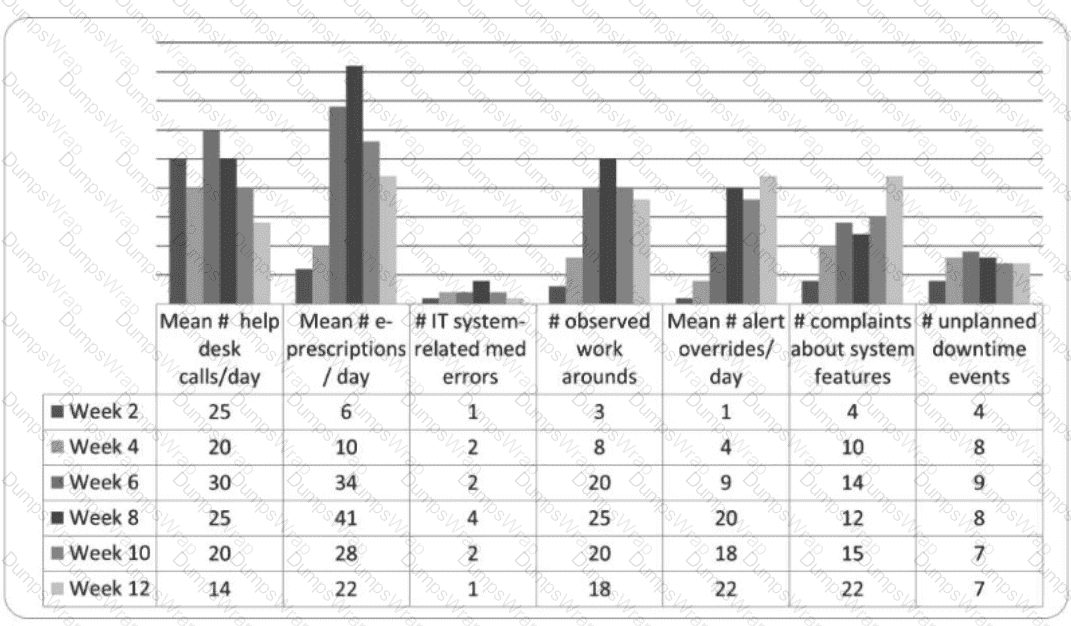
Based on the information above, which of the following conclusions can be drawn?
The safety reporting system being used by an organization cannot produce reports or information in a usable format. After evaluating the existing system and other products on the market, which of the following should the quality professional do before making recommendations to leadership?
A patient safety manager is asked to recommend the best action to reduce medication errors at a hospital. Which of the following is the most appropriate next step?
An important responsibility of each team member working on a team project is to
The quality improvement tool used to identify special-cause variation in a process is a:
The most important component of a successful performance improvement program is:
Which of the following regulatory agencies overseedevelopment of electronic clinical quality measures (eCQMs)?
X quality professional is reviewing medication adherence data for patients with type 2 diabetes. Based on the table below, whichneighborhood should be prioritized for additional interventions?
| Percent of Patients with Type 2 Diabetes Not Taking Medications for 30+ Days | | --- | --- | | Neighborhood | Year 1 | Year 2 | | A | 5% | 10% | | B | 43% | 42% | | C | 20% | 40% | | D | 38% | 44% |
How can a quality professional best engage stakeholders in the organization's quality efforts?
A hospital has just implemented a physician order entry system. Three days into implementation, the users begin having major technical issues with the system. The nurse manager instructs staff to submit troubleshooting requests to the help desk. This is an example of which high-reliability principle?
Medical staff monitoring Indicators are best developed through a collaborative effort between the hospital's quality management professionals and the
An organization Is evaluating the data used to measure compliance with medication reconciliation by clinic. Three abstractors have been assigned to collect the data. The compliance data by abstractor and unit are below:
Based on this table, which of the following Is the best next step to evaluate accuracy andreliability ol the data?
In addition to being a good communicator, an essentialcharacteristic of a quality champion is:
A root cause analysts (RCA) was conducted tor an event related to a delayed high-priority alarm response. Alarm fatigue was determined to be a root cause. Which of the following Is the most appropriate first Intervention?
A physician group with a patient population of 10,000 during the fourthquarter of a year reviewed 100 complaints regarding access to specialty care. During the fourth quarter of the next year, the patient population had grown to 60,000 with 360 complaints regarding access to specialty care. The group has a target goal of five complaints per 1,000 patients. Which of the following should a healthcare quality professional conclude based on the data?
Which of the following action plans contains all key components of a SMART goal to support a strategic plan initiative?
Evaluating data to determine high utilizers of emergency departments and their related characteristics is a strategy that can best help with
An effective way of keeping participants engaged in a meeting is
Team effectiveness can best be evaluated by
The consensus-building group of diverse stakeholders who reviews and endorses measures for public reporting in the U.S. is known as the
Which of the following is a privacy breach according to HIPAA?
To integrate performance improvement with organization planning, there must be alignment between
An effective method to increase an organization’s board of directors engagement in patient safety is to
The quality Improvement (Ql) specialist recognizes that any documents related to medical peer review are
Which of the following is most important for healthcare organizations to improve population health by reducing readmission rates?
Which of the following quality improvement tools is best suited for communicating the scope of a proposed quality improvement project?
The desired outcome of peer review Is to
Which of the following organizations is a deemed status provider for hospital CMS participation?
The facility’s compliance rate on pain assessment is shown below:
Compliance Rate on Pain Assessment
January
February
March
Physicians
40%
50%
20%
Nurses
80%
75%
83%
Physical Therapists
60%
55%
50%
To improve performance, what should be done next?
An employee health program includes a pre-employment health assessment for all prospective employees. The assessment is to be completed, and the results known prior to the assumption of duties. A retrospective study of 200 employees resulted in the information displayed in the following chart:

Review of this information indicates which of the following?
A quality professional is assessing team performance. Which of the following results would be associated when applying evaluation criteria to assess productivity?
A rapid cycleimprovement team has met for six months. The team set a clear aim, gathered data, and identified barriers, but has not conducted any tests of change. Team members are also not completing assignments. Which of the following tools should be used to get the team back on track?
Process improvement projects can be evaluated by using
A quality council reviewed the following results from a performance improvement project:
Diabetic retinal eye exams
Target
Q1
Q2
Q3
>80%
60%
58%
62%
Which of the following should happen next?
The median is defined as the
Annual evaluation of a quality Improvement process must
Which of the following should the team do next?
To best achieve a low rate of harm in spite of inherent risks in healthcare, an organization must:
A healthcare quality professional Is facilitating the establishment of a Quality Council for an outpatient surgery center. The following positions have been selected for membership: medical director, CEO. and CFO. Which of the following Is the most appropriate Individual to add?
Education sessions were held to improve bar code medication administration (BCMA) performance. Six months after completion of education, an analysis showed continued BCMA improvement. What is the key to sustaining this improvement?
A quality professional Is the leader of a team in the storming phase of development Which of the following should the quality professional be prepared to do?
A healthcare quality professional can conclude that clinical performance measures in disease specific certification programs are best supported by the
A healthcare organization had three medication incidents associated with narcotics. None of the events led to permanent loss of function or death, but could be considered near misses. Which of the following would be the best tool to use to identify influencing factors?
Which of the following best describes how a quality professional should conduct an organizational assessment to ensure safe transitions of care?
A nurse working a second overtime shift accidentally administered an oral medication via the patient's IV line. The facility reported this to the accrediting body as a sentinel event. Which of the following is the best solution to prevent this error from happening again?
To assist a primary care physician to improve their performance on a pay-for-performance program, the quality professional should begin with
Which of the following is an example of collaboration for optimal care transitions?
Prior to a regulatory or accreditation visit, a healthcare quality professional should:

